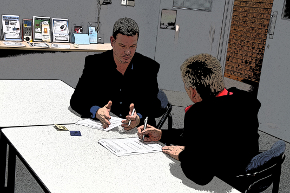Providing scaffolding

Your main task as facilitator is to provide a framework for the learner to work within, and progressively modify or remove it as they increase their expertise and self-directed learning skills.
Because the framework is really a support structure, rather than simply information about the subject matter, it is often called scaffolding.
The degree of scaffolding you provide will depend on the level the learner is working at, and how quickly they pick up a self-directed approach to learning.
One way of encouraging the learner to develop these skills is by identifying problems that they need to solve as part of their work, and then getting them to report on and analyse the process they use to solve it. This is called problem based learning.
Another approach is to use periodic assessment results as a way of providing feedback to the learner on how they're progressing. As we discussed in Section 3, when the assessment process is used to help the learner 'form' new ideas and a greater understanding of a topic, it is called formative assessment.
Some facilitators like to go as far as including the learner in designing and evaluating their own assessment activities. This learner-centred approach is a very effective way of helping the learner to develop an understanding of the performance standards required to achieve competency in the skills they are developing. And because it is carried out in the workplace, it helps to keep the performance criteria highly relevant and enterprise-specific.
Facilitating individual learning
Set out below is an example of a work-based learning program that a facilitator might draw up for an individual. Note that at the bottom of the plan there is a table to record the contacts made between the two parties. This is very important in any program, because the interactions between the facilitator and learner are generally informal, so it would be easy to lose track of them if they were not recorded each time a contact was made.
Individual work-based learning program
Facilitating group sessions
Group facilitation is the process of helping participants to work together in a group training exercise. The most common activities requiring facilitation are group discussions and workshop sessions.
Every group has its own needs, depending on the topic being covered and the way the members interact with each other. In any given group, it's likely that some members will be more forthcoming than others, and may tend to dominate discussions. As the facilitator, you will need to recognise this, and balance the need to let them have their say with the need to enable quieter members to make a contribution.
In other groups, you may find that particular members don't get along well with each other, or have conflicting points of view. Again, your role as facilitator is to make sure everyone follows the protocols of good behaviour and that the session remains productive and well managed.
As the facilitator, the main characteristics you should try to draw out of your group are:
- positive contributions from all participants
- focussed discussions that keep to the point
- an inclusive atmosphere, where all participants and all viewpoints are respected
- coverage of all set topics within the time allowed.
Below is an example of a group facilitation plan. Note that only the Session 1 program outline is shown.

There are many websites run by educational research institutes and corporate training companies that contain information on facilitation techniques. Just type in key words and phrases like: 'facilitation', 'facilitating training in the workplace', and so on.
Here's one to get you started: http://www.businessballs.com/experiential_learning.htm

